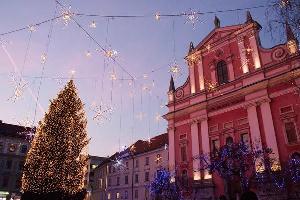Ljubljana’s central square in twilight is a thing of beauty. Fairy lights strung between buildings look like stars against a pinkish-blue sky. A jet plane, its initial trajectory hidden by the façade of a red Franciscan church, cuts across the horizon, leaving behind a faint trail. Adults ride past on bicycles, as kids run around excitedly. Tourists stop by food stalls serving crepes and mulled wine. Beyond the square, cobblestone streets run parallel to a canal shimmering in the street light. I start to hear music, but it’s not the effect of the dreamy setting. There are speakers attached to buildings playing, as if on cue, beautiful western classical music.
“The square is named after France Prešeren, Slovenia’s greatest poet,” a tourist guide tells me the next morning. “We even have a Prešeren Day.”
On Prešeren Day, a national holiday in February to celebrate Slovenian culture, thousands gather around his statue in the square and listen to local actors recite the 19th Century poet’s work out loud. Having been ruled over for centuries — Slovenia has been part of the Roman Empire, the Austro-Hungarian Empire, and finally Yugoslavia — Slovenians have struggled to forge an independent identity. So, it is no surprise that they hold their language and literature close to their heart. In fact, one of the city’s most impressive buildings is their National and University Library designed by Jože Plečnik, one of Slovenia’s greatest architects. In a deliberate attempt at metaphor, the entrance to the library is cloaked in darkness, with a staircase leading to a reading room bathed in natural light.
Later in the day, I hear the strains of a trumpet as I stand outside the Academy of Music. The building’s balcony has a graffiti image of a man smoking out musical notes with a pipe.
“The Academy liked the graffiti, and so they let it be,” says Sandi, an anthropologist who’s written a 400-page book on graffiti subculture in Ljubljana. Recognising the limited audience for his book, he now shares his knowledge through walking tours. But on this day, I’m his only customer. Unperturbed, he gamely leads me on a tour of the city’s walls that are splashed with street art. I learn that graffiti has been around in Ljubljana for the past 70 years. When Slovenia was a part of Yugoslavia, house owners would paint slogans in cow blood, because, in a time of economic strife, it was cheaper than paint.
He informs me that graffiti artists are called writers, and that the most basic form of graffiti is the ‘tag’, a signature image like a cat or a yellow dot; an ‘I was here’ marker. Then there is the ‘throw up’, graffiti done with two colours and in five minutes, quick enough to evade prowling authorities. And finally the ‘piece’, short for masterpiece, which can take anywhere from a few hours to a few days to paint. Ljubljana has embraced, or at the very least made peace with, the graffiti culture. For instance, a Slovenian telecom company commissioned a massive ‘piece’ with the image of Martin Luther King Jr. and the message, “Be a king, talk about love.” Newly enlightened, I start to notice cat drawings and tiny yellow dots everywhere. I recognise names of graffiti crew and inside references like the letter T that a writer includes in all his art because it’s the first letter of his girlfriend’s name. We end our tour at the historic Metelkova neighbourhood, where the barracks of the Yugoslav army used to be. When Slovenia split and the bulldozers arrived, artists occupied these buildings and demanded that they be converted into residences and studios. The artists won, but not without a fight. Today, a statue of David (of versus Goliath fame) stands in front of a hollowed out wall, where the bulldozer’s claws first landed. I spend the night at Hostel Celica in Metelkova. Celica used to be a prison, but has since been transformed into a colourful, welcoming place. Still, I feel trapped when I unknowingly wander into a conversation with a creationist on a mission at the hostel bar.
“When you see a painting you know a painter did it, right?” he asks.
“Yes.”
“How?”
“Someone had to create the painting.”
“Right,” he says. “Something cannot come out of nothing. So, there’s a God who created all of this.”
When I express doubt, he gets louder and more passionate about his cause. I finally wriggle away expressing interest in a concert that’s about to start. Before I’m out of earshot, he’s already talking to someone else: “When you see a painting…”
The band Zamee, an Indo-Balkan collaboration, holds a packed crowd in thrall as a dog naps by their feet. The lead vocalists are Sabiha Khan from India and Nika Solce from Slovenia. A tabla player, a guitarist, a cellist, a drummer and an accordionist accompany them. It’s a wonderful fusion of Slovenian folk and Sufi, and I can barely contain my excitement when they perform a joyous rendition of the classic ‘Mast Qalandar’. The crowd is extremely appreciative, but its loudest cheers are reserved for the band’s performance of ‘Kam’, a soulful adaptation of a poem of the same name.
The response is no surprise when I find out who wrote the poem.
France Prešeren, of course.


Leave a comment